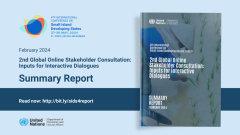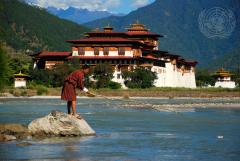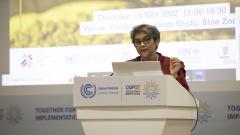- عربي
- 中文
- English
- Français
- Русский
- Español
Cabo Verde hosts UN Meeting on Localising SAMOA Pathway in Small Island Developing States
group-photo-cabo-verde.jpg

PRAIA, 25 July 2019 – Government representatives from small islands and the United Nations are meeting in Cabo Verde over the next two days to strengthen coordination of efforts to localize the SAMOA Pathway* and the 2030 Agenda for Sustainable Development in small island developing States (SIDS).
The government representatives are members of the SIDS National Focal Points network, an initiative by the United Nations Office of the High Representative for the Least Developed Countries, Landlocked Developing Countries and Small Island Developing States (UN-OHRLLS) to improve coordination between the United Nations and island governments in the implementation of the SAMOA Pathway, the dedicated programme of action for SIDS as well as the 2030 Agenda for Sustainable Development.
Speaking at the opening of the meeting, H.E. Paulo Veiga, State Secretary for Maritime Economy of Cabo Verde said “The Focal Points meeting has the advantage of bringing in close contact and collaboration the experts and institutions responsible for the implementation of SAMOA Pathway, enabling, on the one hand, to increase coherence in the handling of SIDS issues in United Nations processes, and on the other, providing an important link between global and national levels, while facilitating coordination, information sharing, lessons learned and planning activities related to the implementation of SAMOA Pathway and the SDGs.”
“This meeting is highly significant as it helps to chart the future direction of the national focal points initiative in order to better support island governments in implementing internationally agreed goals and programmes of action,” said Ms. Fekitamoeloa Katoa ‘Utoikamanu, High Representative for the Least Developed Countries, Landlocked Developing Countries and Small Island Developing States. She added, “I am certain that the outcomes will add great value to our collective efforts in supporting the sustainable development aspirations of Small Island Developing States especially as we set our sights on the upcoming high-level Midterm Review of the SAMOA Pathway in September.”
The meeting will formally adopt Terms of Reference on the functions and activities of the focal points network. Given critical statistical capacity constraints in SIDS, the meeting will also discuss the preparations of a toolkit to harmonize monitoring and reporting on the implementation of the SAMOA Pathway and 2030 Agenda on the ground.
Participants are also expected to discuss achievements, challenges and gaps in the first five years of implementing the SAMOA Pathway as well as addressing linkages between the implementation of the SAMOA Pathway and the wider 2030 Agenda for Sustainable Development and Sustainable Development Goals.
“The SAMOA Pathway lacks a formal mechanism for monitoring and review, said Ms. Lois Young, Permanent Representative of Belize to the United Nations and Chair of the Alliance of Small Island States (AOSIS). She added “this gap has contributed to the lack of data to identify progress and gaps in implementation. And during our preparations for the Mid-Term Review this emerged as a common issue across all action areas of the SAMOA Pathway. We hope to explore practical ways in which we can utilize the overlaps between the SAMOA Pathway and the 2030 Agenda to enhance and streamline monitoring across both, without creating additional reporting burdens.”
The Midterm Review of the SAMOA Pathway will take place on 27 September, 2019 to review all major commitments of the last five years through a SIDS lens – from the 2030 Agenda for Sustainable Development and the Sustainable Development Goals, to the Sendai Framework for Disaster Risk Reduction, the Paris Climate Change Agreement, the New Urban Agenda, and the outcomes of the 2017 Ocean Conference – and how living up to these commitments will help accelerate the implementation of the SAMOA Pathway.





